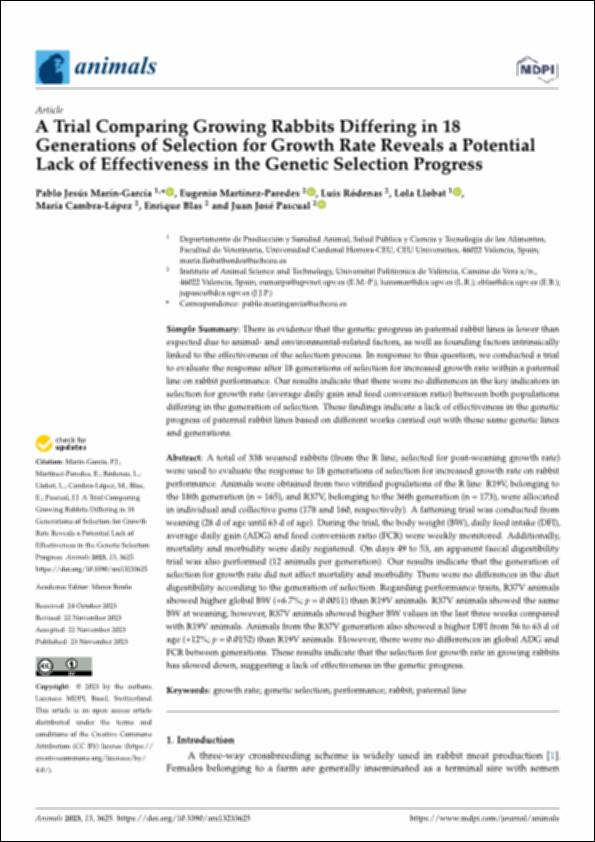Por favor, use este identificador para citar o enlazar este ítem:
http://hdl.handle.net/10637/16068A trial comparing growing rabbits differing in 18 generations of selection for growth rate reveals a potential lack of effectiveness in the genetic selection progress
| Título : | A trial comparing growing rabbits differing in 18 generations of selection for growth rate reveals a potential lack of effectiveness in the genetic selection progress |
| Autor : | Marín García, Pablo Jesús Martínez Paredes, Eugenio Ródenas, Luis Llobat Bordes, Lola Cambra López, María Blas, Enrique Pascual, Juan José |
| Materias: | Conejos; Rabbits; Tasa de crecimiento; Growth rate; Genética animal; Animal genetics |
| Editorial : | MDPI |
| Citación : | Marín-García, P.J., Martínez-Paredes, E., Ródenas, L., Llobat, L., Cambra-López, M., Blas, E. & Pascual, J.J. (2023). A trial comparing growing rabbits differing in 18 generations of selection for growth rate reveals a potential lack of effectiveness in the genetic selection progress. Animals, vol. 13, i. 23, art. 3625 (23 nov.). DOI: https://doi.org/10.3390/ani13233625 |
| Resumen : | A total of 338 weaned rabbits (from the R line, selected for post-weaning growth rate) were used to evaluate the response to 18 generations of selection for increased growth rate on rabbit performance. Animals were obtained from two vitrified populations of the R line: R19V, belonging to the 18th generation (n = 165), and R37V, belonging to the 36th generation (n = 173), were allocated in individual and collective pens (178 and 160, respectively). A fattening trial was conducted from weaning (28 d of age until 63 d of age). During the trial, the body weight (BW), daily feed intake (DFI), average daily gain (ADG) and feed conversion ratio (FCR) were weekly monitored. Additionally, mortality and morbidity were daily registered. On days 49 to 53, an apparent faecal digestibility trial was also performed (12 animals per generation). Our results indicate that the generation of selection for growth rate did not affect mortality and morbidity. There were no differences in the diet digestibility according to the generation of selection. Regarding performance traits, R37V animals showed higher global BW (+6.7%; p = 0.0011) than R19V animals. R37V animals showed the same BW at weaning; however, R37V animals showed higher BW values in the last three weeks compared with R19V animals. Animals from the R37V generation also showed a higher DFI from 56 to 63 d of age (+12%; p = 0.0152) than R19V animals. However, there were no differences in global ADG and FCR between generations. These results indicate that the selection for growth rate in growing rabbits has slowed down, suggesting a lack of effectiveness in the genetic progress. |
| Descripción : | Este artículo pertenece al número especial "Feeding and Management Strategies for Improving Health, Welfare, Efficiency and Sustainability in Rabbit Production". |
| URI : | http://hdl.handle.net/10637/16068 |
| Derechos: | http://creativecommons.org/licenses/by/4.0/deed.es Open Access |
| ISSN : | 2076-2615 (Electrónico) |
| Fecha de publicación : | 23-nov-2023 |
| Centro : | Universidad Cardenal Herrera-CEU |
| Aparece en las colecciones: | Dpto. Producción y Sanidad Animal, Salud Pública Veterinaria y Ciencia y Tecnología de los Alimentos |
Los ítems de DSpace están protegidos por copyright, con todos los derechos reservados, a menos que se indique lo contrario.


